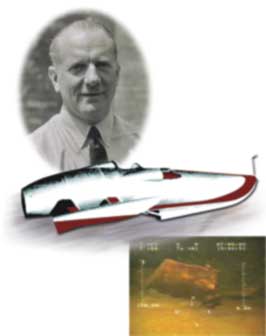The Loch Ness Project 
Loch Ness
Centre
John Cobb's Crusader |
|
|
In August 1952, John Cobb, holder of the land speed record at over 390 mph, brought his jet boat "Crusader" to Loch Ness in an attempt on the water speed record, which then stood at 178.4 mph. Crusader was a masterpiece of craftsmanship. Vosper's build No 2456, was a mixture of thin mahogany and aluminium mounting a De Haviland Ghost engine. On 19th Sept she reached an average speed for two measured mile runs, of 173.14mph but then the weather deteriorated. Snatching a chance calm on the 29th Sept, after a previous cancellation,
the support vessels and timekeepers were rushed into position. Crusader
was lowered back into the water and went straight into the run.
Leaving the measured mile at over 200mph, Crusader appeared to bounce
as she hit a wake and then disintegrated, killing John Cobb whose
body was recovered at the surface. There is still controversy over
the cause of the accident. The floating fragments of Crusader were
gathered and burnt at Temple Pier. The rest of the vessel including
the jet engine sank to the bed of Loch Ness. Using photography, archive film and digital image analysis, the Loch Ness Project began to plot the probable location of the wreck. Over a period of 18 months many long nights were spent mapping the site and sweeping the plotted line with sonar. By June 2002 the Loch Ness Project was satisfied they had found the debris field. At this point Cabaco Marine International Inc. announced an interest in finding the Cobb wreck during the last 2 days of their Loch Ness visit. Adrian Shine presented the Project's data to the team led by Joe Caba. On Thursday the 4th July examination of the sonar contacts began and on Friday 5th July, Adrian Shine was privileged to navigate the barge supporting the Cabaco R.O.V. over the Project's second search line. At 3pm Joe Caba homed his R.O.V. onto the sonar contacts. The remains of Crusader, stark, angular and twisted loomed out of the dark sitting quietly in nearly 200m of water. The cause of the accident was the unexpected persistence
of boat wakes, including sadly, the wakes of Cobb's own support
boats. Speculation about the Loch Ness Monster playing a part was
only true insofar as unrecognised boat wakes do cause the majority
of humped monster reports precisely because of their persistence,
which means they are not associated with the vessel which causes
them. |
|

